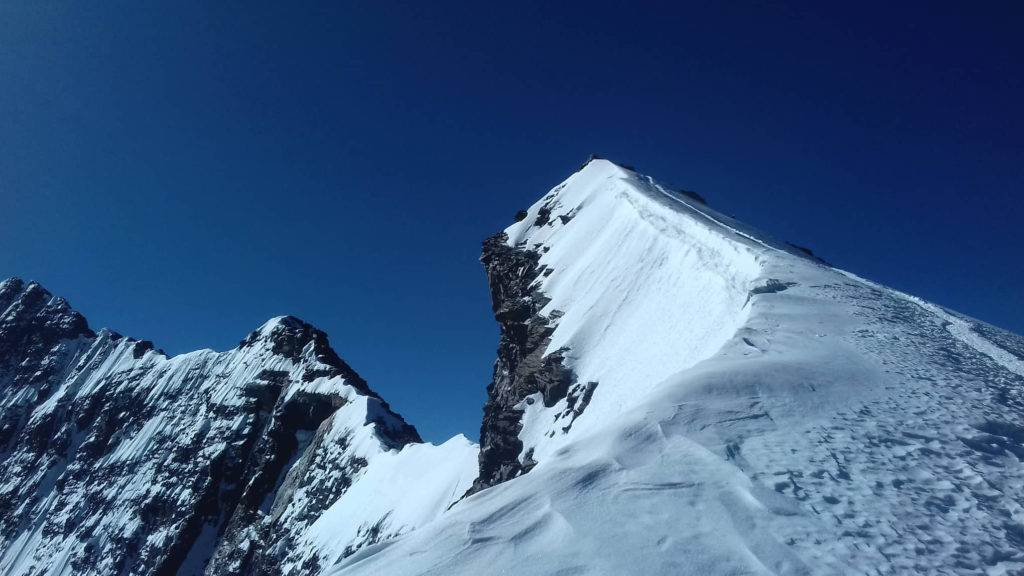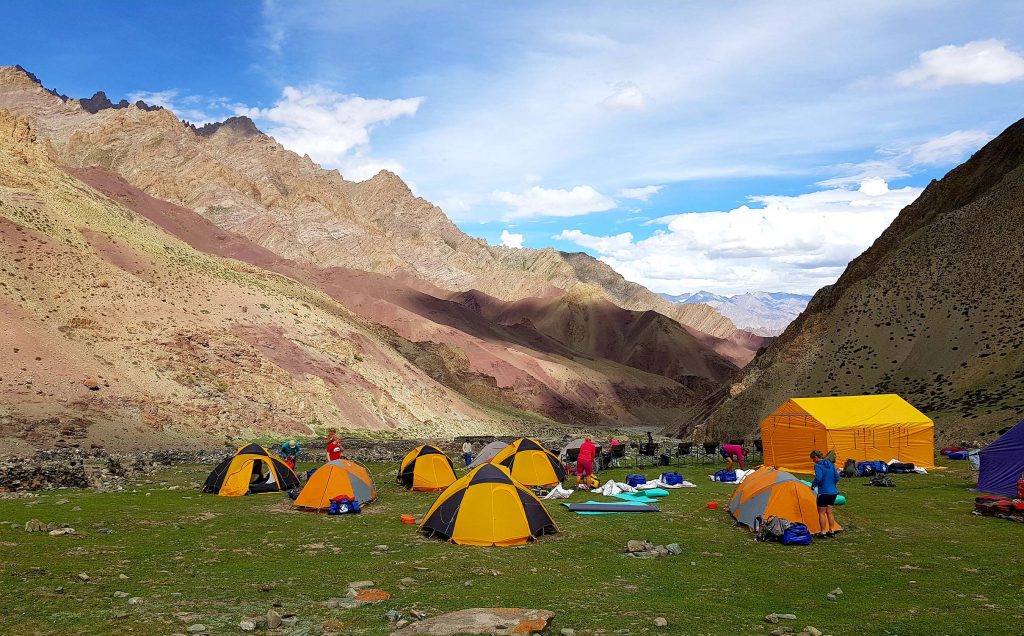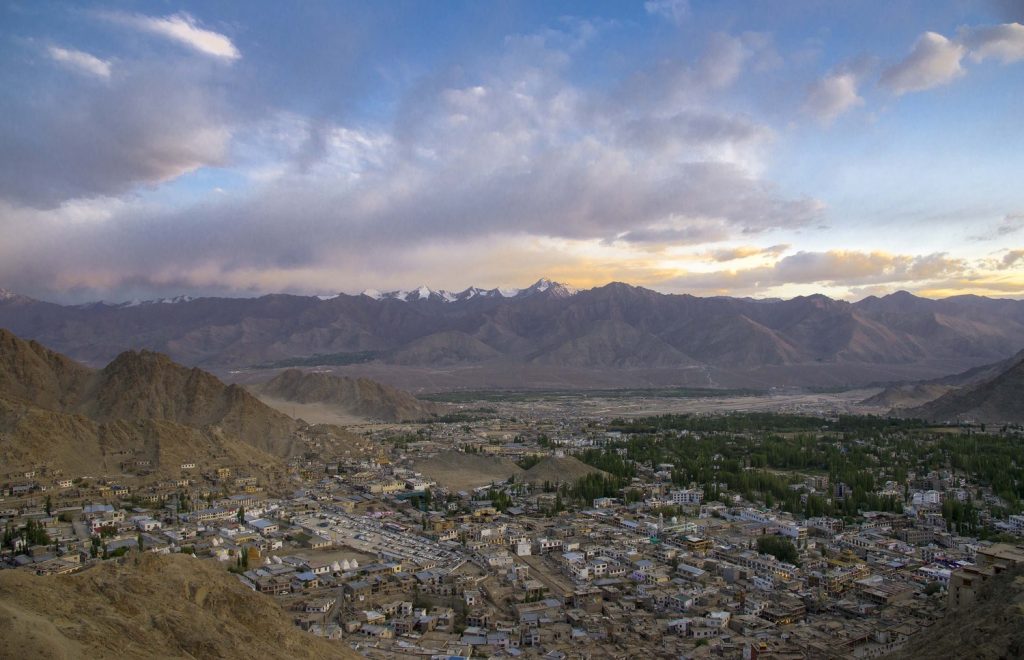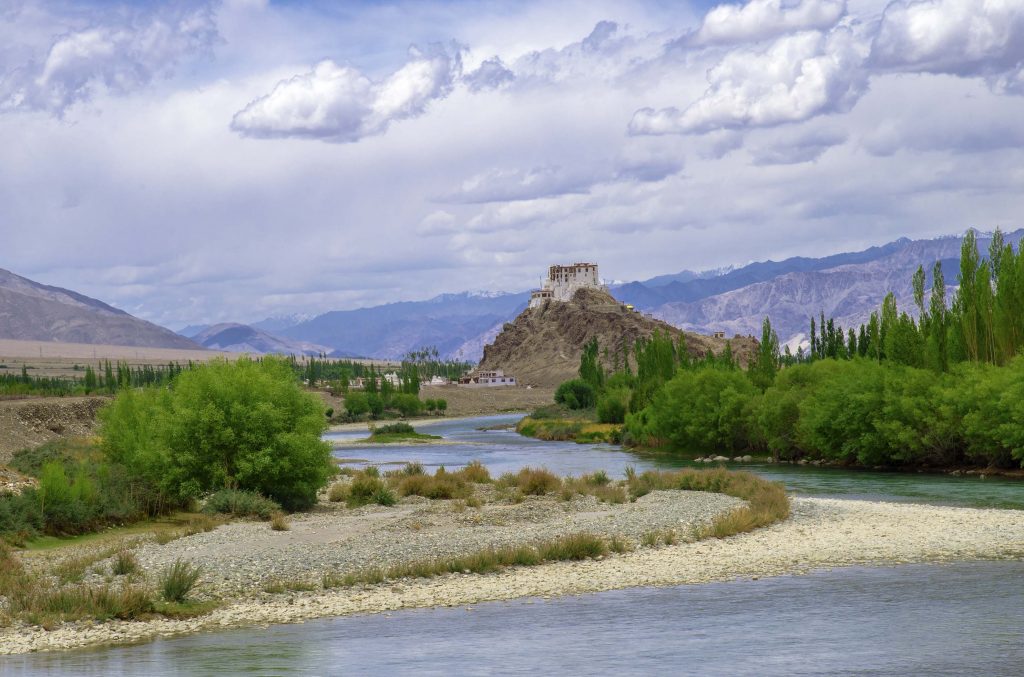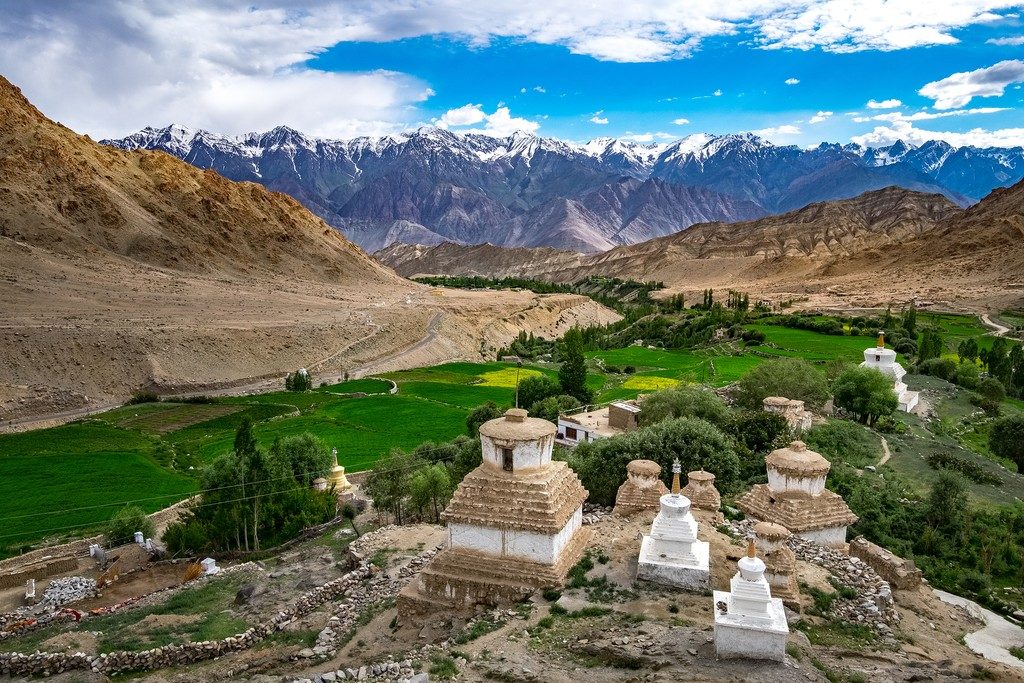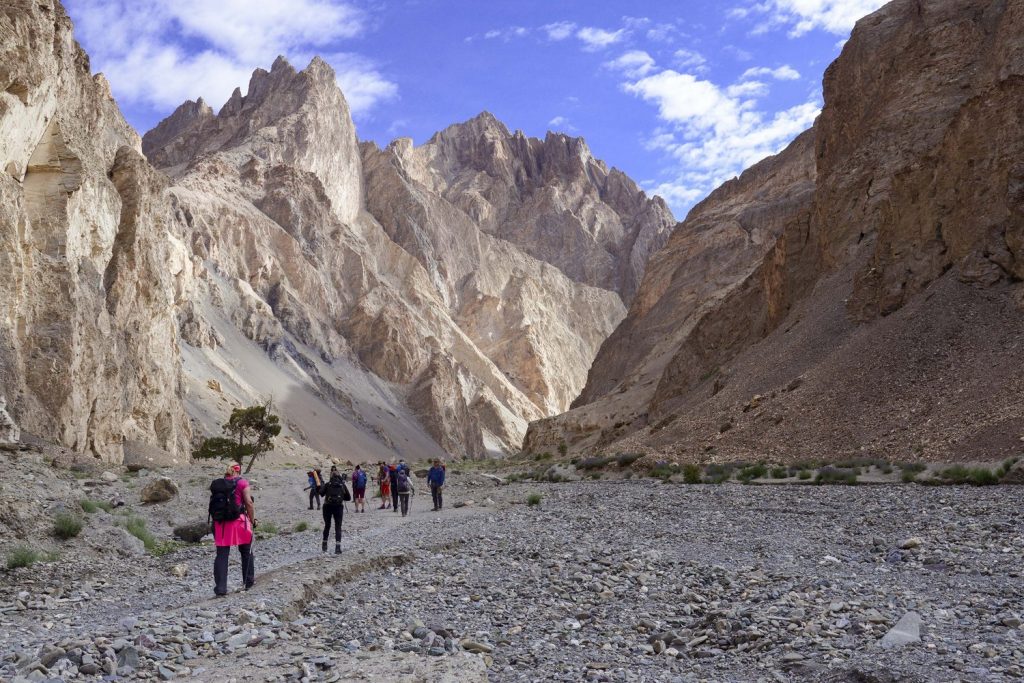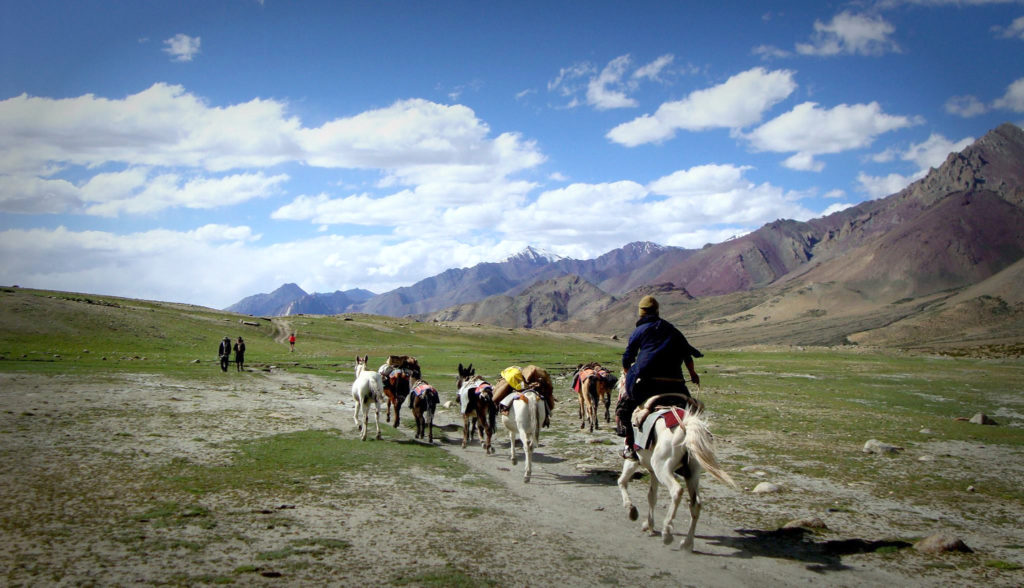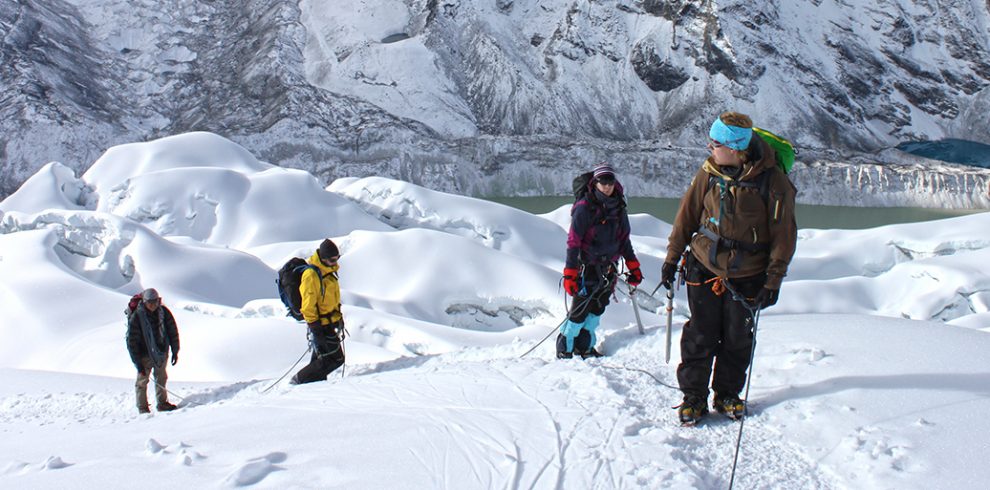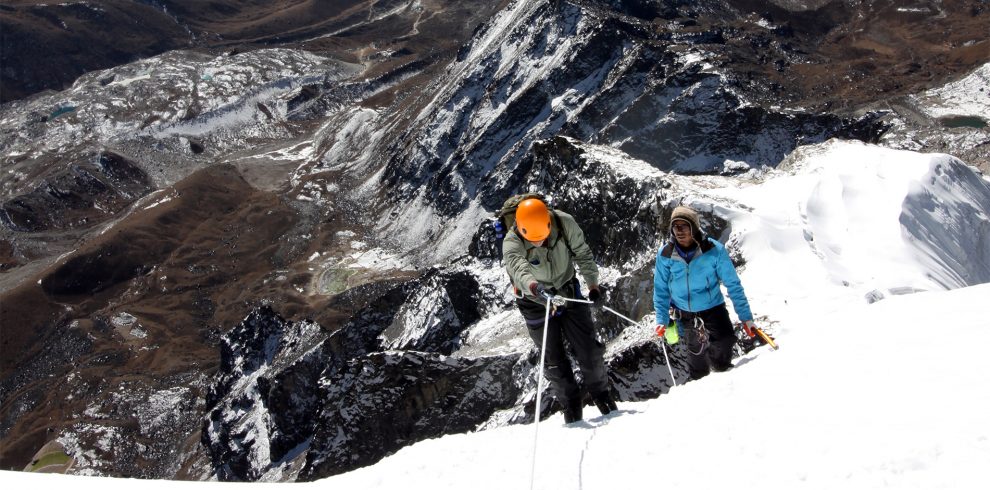Kang Yatse is the most prominent peak in the Markha Valley, towering into a throne shaped peak. There are two summits on this mountain. The main summit is higher at 6,400 m which is a technical climb involving a traverse across a knife-edge ridge. We will climb the lower western summit at 6,250 m. The Markha valley offers the perfect acclimatisation trek needed for this climb. The trek through this valley takes you through quaint villages, arrays of stupas and mani walls (stones inscribed with Buddhist prayers), old monasteries, ruined forts and beautiful homestays. On a clear day you see views as far Nun Kun & Zanskar ranges in the West & the K2, Broad Peak & Gasherbrum Massif in the far North.
Overview
This trip is a perfect first “Himalayan Summit” experience. It is especially for those keen walkers who want a little more adventure than an ordinary trekking holiday, or if looking for a 6000 m climbing adventure.
After arrival to New Delhi, we fly in to the Ladakhi capital of Leh, where we spend the next 4 days acclimatizing. During these 3 days we visit monasteries around Leh and also do a day trek from Likir to Yangthang for acclimatization.
The trek to Khang Yatse Base Camp ventures into the breathtakingly beautiful Markha Valley. This journey in its own is magical and beautiful as we cross high passes and gentle meadows. We gradually gain altitude as we trek through the valley of Markha and to the Nimaling Plains.
The ascent of Khang Yaztse is safe from objective dangers, and is technically straightforward climb, involving around 35 degrees scree and snow slopes with a short section of ridge climbing. The summit is a beautiful dome with wide ranging views. On a clear day you can see as far as the Karakoram Range and K2, about 200 Km to the North West.
Although this is not a technically demanding climb, the altitude of over 6000 m makes it physically demanding. Previous crampon experience is preferable but not essential.
Highlights
- A superb introduction to Himalayan climb
- Climb a 6250m summit
- Experience the magical beauty of Markha valley trek
- Explore Leh
- Centuries old monasteries of Likir, Hemis and Thiksey
- Day hike through the beautiful villages in the Sham Valley
- Trek partly through Hemis National Park- the realm of the Snow Leopard
- Rickshaw ride through the narrow lanes of Spice market in Old Delhi
- Visit to Taj Mahal (add on)
Itinerary
Altitude: 216m
On arrival to Indira Gandhi International Airport at New Delhi and after finishing with the immigration and custom formalities, our representative will meet you at the Main Exit with a Hi On Life Adventures placard. It is about 15 to 20 mins drive to the Aerocity where we have chosen your hotel for the practicality for the next days early morning domestic airport transfer. When you arrive at your hotel you will be briefed about your trek and “do’s and don’ts” while your stay in India. In the evening we will have a welcome dinner to begin the taste of India at one of the finest dining in New Delhi.
Overnight Hotel Pride Plaza or similar
Altitude: 3500m
Flight duration: 1 hour 25 mins
Early morning drive to the domestic airport to fly to Leh. Be prepared for an extensive security checks for your own safety owing to the fact that Leh is strategically located close to Pakistan and China. Baggage allowance Delhi-Leh is only 15kg per person, unless you have a through ticket on the same airline internationally. However, excess baggage charges are only $6 per kilo. It will be an early morning flight to Leh which is a fantastic mountain flight. The flight takes about 1 hour and 20 mins to Leh and approach to the airport at Leh is extremely scenic, so get your cameras ready. The airport at Leh is also an Indian Air Force Base, therefore it is heavily guarded and again extensive security checks. We will be received at the airport by a representative from Ladakh and will be transferred to our hotel. An important component of our trip that we must adhere to is the acclimatization required due to high altitude. Hydration is the key to cope up with the high altitude, so drink water regularly. We will take this first day at high altitude with leisure and maximum exertion should maybe be a small stroll outside to the neighboring shops.
Overnight Hotel Pride Plaza or similar
Altitude: 3500m- 3100m
Sightseeing duration with drives: 5 to 6 hours
We begin with a 40 km drive to Hemis. The wealthiest monastery of Ladakh and India, Hemis Monastery belongs to the Drukpa lineage of Tibetan Buddhism. The monastery was re-established in 1672 by the Ladakhi king Sengge Namgyal. After visiting Hemis monastery, we will visit Thiksey monastery. Thiksey monastery is affiliated with the Gelug sect of Tibetan Buddhism. It is located on top of a hill in Thiksey approximately 19 kms east of Leh. It is noted for its resemblance to the Potala Palace in Lhasa, Tibet and is the largest monastery in central Ladakh.
After the sightseeing, we will drive back to our hotel. The rest of the afternoon is free.
Overnight Hotel Spic N Span or similar
Altitude: 3100m- 3610m
Drive: 55 kms, 90 mins hours one way
Trek: 3 hours
We drive along the river Indus till Likir monastery, which is again an extremely scenic drive. From Likir we begin our trek on a jeep road until we reach a small pass called Phobe La (3580 mts). From here we leave the jeep road and walk an off the beaten track. After an hour walk we arrive at Sumdo village, cross the river and continue in the valley and finally reach the summit of Charatse La (3700 mts). From the summit descent to Yangthang Village. Yangthang is a beautiful agricultural village. After spending some time at the village, we drive back to Leh by late afternoon.
Today your guide will organize a short walk to Leh monastery for further acclimatization. You can utilize the rest of the day for last minute preparations before the trek.
Overnight Hotel
Elevation of Skiu: 3360m
Drive: 56 kms 2 hours
Trek: 7 kms 2 hours
From Leh we drive to Sangam near Nimmo where the Indus river meets Zanskar river. From here we leave the Indus river and follow the Zanskar river and rive to Chilling where we cross the Zanskar river. The trek starts from here and we walk about 7 kms the first day.
Overnight camping
Elevation of Markha: 3760m
Time: 6-7 hrs
Distance: 21.2 km
The trek from Skiu to Markha follows the river and passes through small villages. It is a fairly easy trail today. The village of Markha consists of around 20 households, it is the biggest village in the valley. We will visit the ancient gompa and the ruined fort above the village.
Overnight camping
Elevation on Hankar: 4030m
Time: 4-5 hrs
Distance: 11.2 km
The trail is again fairly easy following the river with a gentle ascend. We will visit the small but impressive cliff-side monastery of Techa located a few kilometers before Umlung village.
Overnight camping
Elevation of Nimaling: 4840m
Time: 5-6 hrs
Distance: 10.7 km
We continue our trek to the plateau of Nimaling which is the summer pasture for the livestock of Markha valley. Today is a bit of a climb and in total we gain about 850m. Overnight camping
Elevation of Base Camp: 5100m
Time: 2 hours
Distance: 2 km
Today is a short day. The first half of the trek climbs on loose rocks and the latter half of the trail is an easy descend. There are splendid views of Khang Yatse from the trek. About two hours trek will bring you to Khang Yatse Base Camp at 5,100 meters.
Rest of the afternoon can be utilized to get your climbing gears organized, easy short hikes around Base Camp or just chill out.
After breakfast we will get your climbing gears organized. Your guides will conduct a safety briefing and give instructions on usage of technical equipment. You will be taught how to walk in the snow, using crampons, handling of ice axe, and other techniques that are useful for this summit.
After lunch we will take a short height gain trek for acclimatization. Pack your backpack for the summit day while it is still daylight, keep it light and easy. You will have dinner early to wake up midnight for the climb.
Elevation of Khang Yatse II: 6,250m
Trek/ Climb: 12 hours return
Distance: 5 km each way
We begin around midnight for the summit push. The climb is about 1100 meters, therefore it is essential to be focused. We begin with a climb through loose moraine and scree. Glacial rope traverse will be necessary since there are a few crevasses. The route follows the north face through the northwest ridge to reach the famous Kang Yatse shoulder. From here it is a fairly steep climb to the summit.
On the summit, you will be surrounded by a 360 panorama of the Zanskar range, Karakoram peaks and mountains surrounding Kang Yatse. On a clear day it is possible to see Mt. K2. You can also see the distant peaks of Tibet.
After spending a short victorious moment at the summit, we start the long climb down to Base Camp. Be cautious on the scree and moraines.
Contingency day is to account for bad weather or other unforeseen circumstance.
Elevation of Kongmaru La: 5200m
Elevation of Chuskirmo: 4600m
Time: 7 hours
Distance: 16 kms
The trek is a steady ascent to Kongmaru La pass, although it is not very steep. At the pass you will be pleasantly welcomed by the Karakoram Range and the excellent array of peaks. It is possible to see Mt. K2 on a clear day from the pass.
After the pass a trek of 4 hours will bring you to Chuskirmo. The route has a steep descent and rocky terrain in the beginning which gradually gets less steep as we reach a stream. Soon we reach Chuskirmo which is marked with chortens and shops.
Elevation of Shang Sumdo: 3600m
Time: 2 hrs
Distance: 3 km
Drive: 50 km, 1 ½ hrs
An easy trek along the Shang River for couple of hours will bring us to Shang Sumdo and to the road head. Here, we get into our vehicles and drive to Leh via Hemis monastery. We will reach our hotel at lunch. Rest of the afternoon is free to walk around the interesting market in Leh.
Early morning flight to New Delhi. Due to airport security regulations, no cabin baggage is allowed on any flights originating from Leh. Upon arrival to Delhi, we drive to Aerocity and check in to our hotel. At around 3 PM we will take a sightseeing tour of Old Delhi.
The sightseeing begins with a drive through the historical monuments and government buildings of New Delhi. New Delhi was established by the British and most of the buildings were built in the Lutyen style. Sir Edwin Landseer Lutyens, was an English architect known for imaginatively adapting traditional architectural styles to the requirements of his era. He designed many English country houses, war memorials and public buildings in New Delhi.
After a short drive through New Delhi, we enter the heart of Delhi, the Chandni Chowk. Suddenly you are in another era of history and culture. We will take a rickshaw ride through the narrow lanes of the Spice Market and Bride’s market, more commonly known as the Khari Baoli. It is a fascinating ride where you can witness real India, with people literally walking over each other, deafening noise along with the vibrant colors that Indian is known for, and intriguing aroma of the spices and food.
Overnight Hotel
You will be picked up from your hotel and driven to Indira Gandhi International airport 4 hours before departure time.
Cost
Cost Includes
- Arrival/ departure and all internal transportation while in Delhi in private vehicles
- Welcome dinner at Delhi’s finest Indian restaurant
- 2 nights hotel in Delhi at 5 star hotel
- ½ day sightseeing in Delhi with rickshaw ride through the narrow lanes of the Spice Market and Bride’s Market
- Round trip flight from Delhi / Leh/ Delhi
- 5 nights in Leh at tourist class hotel with all meals
- Transfers from airport/ hotel/ airport in Leh
- All Monastery fees.
- Wild life fee and Kang Yatze Expedition permit fees
- 1 English speaking guide
- 1 Experienced Climbing Sherpa from Nepal
- 1 Experienced Cook from Nepal
- Local kitchen helpers and mule herder with mules
- All meals while camping with all camping facilities
- Boiled and treated water 3 times a day
- Sleeping tent/ dining tent with comfortable tables and chairs/ kitchen tent/ toilet tent and shower tent
- Combination of Ridge mat and Exped 7 W Down Mattresses for sleeping in the tent
- Complimentary Hi On Life duffle bag (90 litres) to take away
- Use of 1 sleeping bag (-20C/ -4F) with fleece inner liner for sleeping bag
- Use of Hi On Life down jacket and rain poncho
- 15 kgs personal baggage allowance per member
- Bottled oxygen with mask & Regulator for Medical Use
- All personal climbing equipment except climbing boots and crampons
- Staffs Insurance/ wages and equipment allowance
- Extension: Transportation to Agra and back in private A/C car, Full day sightseeing in Agra (Taj Mahal and Agra fort), 1 night at 5 star hotel in Agra, 1 night at 5 star hotel in Delhi
Cost Excludes
- Insurance: Travel/Accident/Medical /emergency evacuation
- Private room accommodation in Delhi and Leh unless a single supplement is paid.
- Staff tipping
- Indian Visa
- Telephone, laundry, mineral water, soft drinks and alcoholic beverages.
- Emergency rescue evacuation cost if needed
- All other personal nature expenses.
Map
Markha valley trek
The Markha valley is part of the Hemis National Park, home to snow leopard and other wild animals.
The Markha valley trek is a very famous trek and all the villages in the valley offer homestay which is a nice opportunity for travellers to catch a glimpse of the daily lives of the villagers.
Your dinner will be served around 7 PM.
High Altitude
On this trek you will be going up to 6153m, so it is very important to understand the affects of altitude. The greatest provocation is going too high too fast. Hi On Life Adventures’s itinerary has been carefully designed to minimize the effects of altitude. We ascend slowly and surely allowing enough time for safe acclimatization. Headaches and breathlessness are common at altitude which in itself is nothing to worry about. In rare cases, this may worsen to Acute Mountain Sickness (AMS), so a close watch is kept on all trekkers by the group leader who is trained to recognize the symptoms of AMS. The symptoms of AMS are severe headaches, nausea, lethargy, loss of appetite serious breathlessness even at rest. If any trekkers show such signs they will be descended to relatively lower and safer altitude. The Group Leader’s decision on evacuating such person to a safe altitude is final. Do not medicate yourself without first informing your group leader. A slow and steady ascend with adequate rest and adequate intake of fluid (3 to 4 litres per day) is the key to acclimatization. By doing so, you will most likely have no problems apart from breathlessness on hills which is completely normal as the percentage of Oxygen in the air is relatively lower to that at sea level. The most important thing is not to worry about altitude because our team is there to take care of you.
Staff
Group leader: Your most important member of your staff. Our Group leaders are highly trained in all aspects of the trek, conservation, first aid specializing on
altitude sickness, emergency procedures and have extensive knowledge of the natural history of the area.
Sirdar: His job is to manage and organize staff duties, select and organize campsites. He is responsible for the actual operation of the trek.
Sherpas: Their job is to lead your way, help managing campsite, help loading horses and also help clients when need arises.
Horses and mules to carry luggage and their handlers (horsemen)
Please note: In our Ladakh trips, we do not use porters.
Weather
The best time for this trek is June till August. It is summer time in Ladakh and the temperatures are pleasant at high altitude. However, below 3500m it can be soaring 28 C in the sun. Another typical thing about the climate in Ladakh is that the temperature varies enormously. It can be 28 C+ on a sunny day and within an hour the temperature could drop below 10 C if it gets cloudy. At altitudes above 4500m the night time temperatures could drop just below freezing. Even though Ladakh lies in the rain shadow area, you might still encounter a short shower since it is monsoon time.
On the summit day: You can expect between -2C to -5C + wind chill factor depending on the wind speed
Recommendations for things you should bring:
Clothing:
Head:
- Warm hat wool or synthetic that covers your ears
- Sunhat
- Glacier sunglasses with side shields
- Headlamp with extra batteries
- Bandana or head scarf, also useful for dusty conditions
Upper Body:
- 2 cotton t-shirts for warm days
- 2 polypropylene or wool mix long sleeve t-shirts
- 2 long sleeve thermal underwear shirts, lightweight preferably woolen
- 1 polar fleece pullovers medium weight or 1 heavy wool thermal underwear
- 1 polar fleece jacket, OR Primaloft/ Down light weight jacket
- Gore-Tex jacket with hood, waterproof and breathable
- Please note: We provide 1 very warm goose-down jacket with hood for high altitude.
Hands:
- 1 pair light weight wind stopper gloves
- 1 pr. lightweight poly-liner gloves
- 1 pair mittens, consists of 1 Gore-tex over mitt matched with the warm polar Fleece mitt liner
Lower Body:
- 1 pair walking shorts
- 1 to 2 pair walking trousers for trekking
- 2 pair lightweight thermal bottoms
- 1 pair medium or expedition weight thermal bottoms
- 1 pair Primaloft OR light weight down trouser for evenings at Base Camp
- 1 pair Gore-Tex trousers, Waterproof/breathable with side zips
Feet:
- 1 pair trek/climb boot preferably for 6000m+
- 1 pair trainers (running shoes) and/or sandals for Delhi, Leh and in camp
- 2 pair med-heavy preferably wool socks
- 2 to 3 pair of liner socks. Polypropylene or wool
- 2 to 3 pair lightweight trekking socks, poly or wool
Sleeping:
We provide:
- 1 down sleeping bag (rated to – 20 Centigrade or -4 F )
- 1 polar fleece liner
- Exped Down 7W mattres and foam kari-mats.
Rucksack and Travel Bags:
- 1 medium rucksack (30-35 litres)
- We provide one 65 lts duffle bags for each member.
- Small padlocks for duffel kit bags.
Accessories:
- 1 small roll of repair tape, 1 sewing repair kit
- Nylon stuff sacks for food and gear storage, large Ziplocs are useful also
- 3 Water bottles (1 litre each)
- Books, playing cards, ipod/mp3 player, games etc
- Adequate amount of batteries, etc.
- Money belt
- Toiletries: Your essentials. We provide toilet papers
- Towel: Quick dry travel towel
- Penknife
- Disposable lighter
- Medical kit: As per your prescriptions. It should be noted that the group leader will be carrying a first aid kit.
Optional
- Walking sticks ( highly recommended)
- Cameras
- Knee guard for those with bad knees.
- Daytime snack (chocolates/ dry fruit trail mix)
Healthy and trouble free holiday
Please consult a doctor for vaccination against Typhoid, Meningitis, polio, and hepatitis. If you have special dietary requirements or allergies, please give us a list of what you can and can’t eat so that we can provide proper food for you. If you are undergoing a course of prescription medicine, please ensure that you have sufficient supplies for the entire holiday. Some types of drugs including anti malaria have side effects at high altitude; therefore please consult your doctors regarding these drugs. The places you trek are mosquito free and there has been no report on malaria in Ladakh and you do not spend a lot of time in the low
lands of India.
Money Matters
The ideal currency to bring with you is USD or Euro. You can exchange them in Delhi or Leh. You can also draw money from ATM machines in New Delhi or Leh.
The exchange rate is 1 USD = 68 Indian Rupees approx. (subject to change)
During the entire trip the only meal that you need to pay for is 1 dinner and 1 lunch in Delhi. If you have chosen to add Agra trip with this trip, then you need to pay for 2 more dinners and 2 more lunches. Delhi and Agra has a wide variety of restaurants with a very wide range of price. Depending on where you eat, each meal will cost anything between 5 to 25 USD + drinks. Plus 20 to 30 USD for your taxis if you wish to go around the city.
On trek: Basically there are no places where you can spend money on the trek. However, in few places you might find small tea shops that sells cold drinks, chocolates etc. It is recommended to bring around 5 USD per day. This money is chocolates, soft drinks and beers etc and also for small donations in the monasteries.
Tipping
Although tipping is entirely optional and personal matter the following is recommended as a guideline
In Delhi and Leh: for bellboys, waiters and porters 50 to 100 Indian Rupees
On the trek: At the end of the trek it is a customary to tip the field staff. The recommended amount is 100-150 USD depending on group size. The Group leader will collect the tip and then split it according to responsibilities of each staff and put it in envelopes with their names on it. this envelopes are given back to you, so that you can give it to the staff during the “Farewell Ceremonies”. Please note- the Group Leader is not included in this tip. If you wish to tip the Group Leader, you can do it separately.
Some Do’s and Don’ts
Ladakhi people treat visitors as special guests. Although they will never rebuke you publicly for unknowingly offending them, we must consider their culture.
While in Ladakh please observe the following:
- Full or partial nudity is not accepted.
- Over display of affection between men and women, especially in temples and monasteries are discouraged.
- Please remove your shoes before entering monasteries and temples.
- Never point the soles of your feet at a person or shrine.
- Locals walk around the Mani walls and Stupas in a clockwise direction as a respect and they expect you to do the same although it is not compulsory.
- Please ask before taking pics of a person or his/her child
Some useful tips while travelling in Delhi and Agra
Dress code: Dress sensibly. For men- knee length shorts and t shirts and sandals are best to cope up with the heat but in some temple and mosques you need to wear long trousers. For women it would be wise to cover up and dress modestly to avoid unwanted advances. Light cotton trousers or knee length skirts are ideal. Avoid too high cut shorts and bare back dresses.
Personal space: The concept of personal space is almost nonexistent in almost all over India. Whether you’re standing in a queue or walking in a crowded Bazaar, get used to moving shoulder-to-shoulder.
People in North India tend to stare a lot: Please don’t be offended because most of them do this out of curiosity. Easy way to deal with this is to not make direct eye contact with strangers and passersby. Get used to it and don’t let this make you uncomfortable. Wearing sunglasses helps a lot ignore staring.
Bargaining skills: In shopping malls the prices are fixed and you cannot bargain. However, in rest of your shopping adventure, it is inevitable that you will be exploited to a certain degree. The simple fact is that most vendors know you have money. Skillful bartering takes practice- a beginner’s rule of thumb is to cut the starting price in half and then work your way to a middle ground.
Beware of Pickpockets: The streets of Delhi can become very crowded, exposing you up to a risk of being easily pick-pocketed. Keep your money in your money belt or in a forward facing backpack. If you need to take money out of your wallet, it is best to do it with least possible exposure of the wallet.
Beggars: You will likely see things that strike your emotional core, but it is important to realize that these are deep rooted problems with no easy fix. Moreover if you give money to one beggar, within seconds you will find yourself surrounded by a dozen other beggars from children to adults. Also keep in mind that beggar mafias control much of the inner city.
Street Hawkers: When you walk out of the sightseeing points you will meet several hawkers trying to sell you small souvenirs from pics and all sorts of things. Do not engage in a bargain or conversation unless you really want to buy them. They can be very pushy sometimes.
Go With the Flow: Despite the fact that the cities in India can be tiring with all the staring, crowded streets, beggars, pestering hawkers’ etc. try not to care about the small stuff. If you get caught up and stress about the little things, you will miss out on the bigger picture, which is that you are in one of the most distinctive and important cities in the world. The city will often come to feel like another planet entirely.
“TODAY IS YOUR DAY! YOUR MOUNTAIN IS WAITING, SO… GET ON YOUR WAY!”
DR. SEUSS


